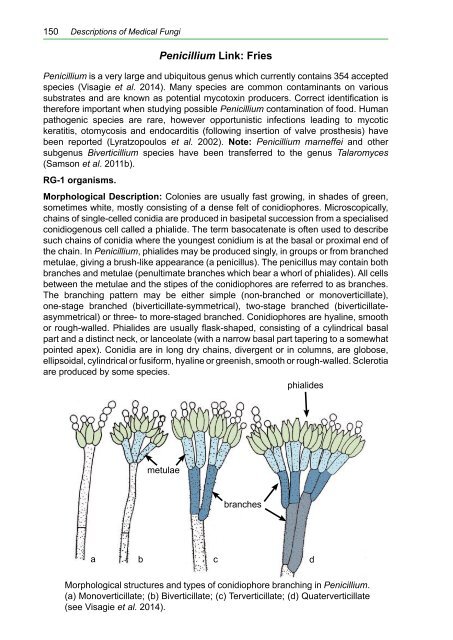DESCRIPTIONS OF MEDICAL FUNGI
fungus3-book
fungus3-book
Create successful ePaper yourself
Turn your PDF publications into a flip-book with our unique Google optimized e-Paper software.
150<br />
Descriptions of Medical Fungi<br />
Penicillium is a very large and ubiquitous genus which currently contains 354 accepted<br />
species (Visagie et al. 2014). Many species are common contaminants on various<br />
substrates and are known as potential mycotoxin producers. Correct identification is<br />
therefore important when studying possible Penicillium contamination of food. Human<br />
pathogenic species are rare, however opportunistic infections leading to mycotic<br />
keratitis, otomycosis and endocarditis (following insertion of valve prosthesis) have<br />
been reported (Lyratzopoulos et al. 2002). Note: Penicillium marneffei and other<br />
subgenus Biverticillium species have been transferred to the genus Talaromyces<br />
(Samson et al. 2011b).<br />
RG-1 organisms.<br />
Penicillium Link: Fries<br />
Morphological Description: Colonies are usually fast growing, in shades of green,<br />
sometimes white, mostly consisting of a dense felt of conidiophores. Microscopically,<br />
chains of single-celled conidia are produced in basipetal succession from a specialised<br />
conidiogenous cell called a phialide. The term basocatenate is often used to describe<br />
such chains of conidia where the youngest conidium is at the basal or proximal end of<br />
the chain. In Penicillium, phialides may be produced singly, in groups or from branched<br />
metulae, giving a brush-like appearance (a penicillus). The penicillus may contain both<br />
branches and metulae (penultimate branches which bear a whorl of phialides). All cells<br />
between the metulae and the stipes of the conidiophores are referred to as branches.<br />
The branching pattern may be either simple (non-branched or monoverticillate),<br />
one-stage branched (biverticillate-symmetrical), two-stage branched (biverticillateasymmetrical)<br />
or three- to more-staged branched. Conidiophores are hyaline, smooth<br />
or rough-walled. Phialides are usually flask-shaped, consisting of a cylindrical basal<br />
part and a distinct neck, or lanceolate (with a narrow basal part tapering to a somewhat<br />
pointed apex). Conidia are in long dry chains, divergent or in columns, are globose,<br />
ellipsoidal, cylindrical or fusiform, hyaline or greenish, smooth or rough-walled. Sclerotia<br />
are produced by some species.<br />
phialides<br />
metulae<br />
branches<br />
a b c d<br />
Morphological structures and types of conidiophore branching in Penicillium.<br />
(a) Monoverticillate; (b) Biverticillate; (c) Terverticillate; (d) Quaterverticillate<br />
(see Visagie et al. 2014).





